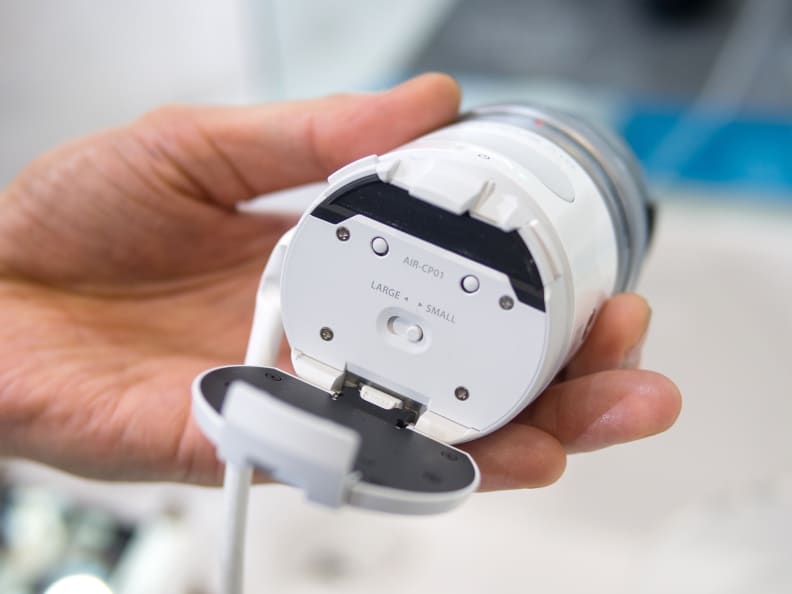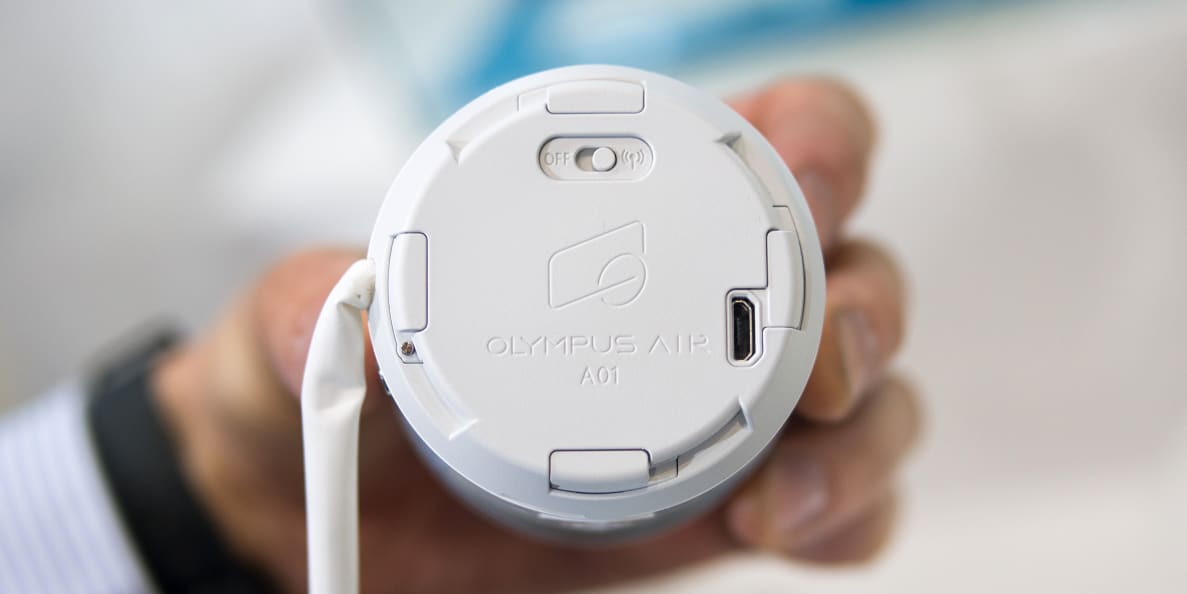In 2013, Sony debuted a new camera concept with its QX-series “lens-type cameras.” That awkward phrase originally referred to a self-contained lens-and-sensor module that connects to your smartphone via WiFi and provides better-than-smartphone image quality… on your smartphone. Last fall, Sony followed up on its original QX10 and QX100 modules with the new QX1. It did away with the integrated optics and let you mount any Sony E-mount mirrorless lens to your phone (along with A-mount SLT lenses, using an adapter).
Sony enjoyed a solid year and a half as the only maker of smartphone attachment cameras, but that run has come to an end. Last week, Olympus announced the Olympus Air A01, a wireless lens mount module that packs a 16-megapixel Micro Four Thirds sensor and can mount any M43 lens. This week, we got our hands on it at CP+ 2015 in Yokohama.
Design & Usability
A sleeker, sexier smartphone companion
It’s clear that Olympus has been keeping a close eye on Sony. The Air takes many of the same design cues: a smartphone mount that connects to the camera module with a bayonet, minimal ports and physical controls, and a simple cylindrical shape. But the Air is a much more enjoyable device to use, thanks to a few key differences.
For one thing, it's small and light. The Air is just 57.1mm across by 43.6mm tall, and tips the scales at only 5.2 ounces. In comparison, the QX1 measures 74mm x 53mm, and weighs 7.6oz. That's not a huge difference, but when you're stowing it in your pocket or purse, or mounting it to the front of a slim smartphone, every millimeter matters.
Then there’s the shutter button. It’s a huge, rubberized oval that wraps around the top of the mount module. The QX cameras use a small, hard, round shutter button placed on the left side of the module. We actually like Sony's left-side placement better, but the Air’s implementation—from the large size to the feel of the half-press-to-focus—is superior in every other respect.
Finally, there’s the smartphone mount. The QX cameras position your phone screen perpendicular to the lens, meaning you need to shoot at eye level. The Air, on the other hand, pitches the screen at about a 45-degree angle, letting you shoot at waist or chest level. It’s a simple change that makes the Air a lot more comfortable to use.

When mounted, your phone is positioned at a roughly 45-degree angle—a big improvement over the QX series.
The phone mount even includes a switch that physically toggles the mount position between modes suitable for smaller and larger phones. According to the Olympus reps we spoke to, the large setting was sized for the iPhone 6 Plus and other phablets (like the Samsung Galaxy Note 4), while the small setting is suitable for an iPhone 6-sized device.

The Air's smartphone mount is quite flexible, toggling between phablets and regular smartphones via a switch, with an extending arm that can accommodate a multitude of additional size variations.
Of course, you don’t have to shoot with the module mounted to a smartphone. The beauty of the concept is that the Air can go anywhere you want it to, provided it’s within WiFi range of your smartphone. That means you can mount it on the ceiling, toss it in a bridal bouquet, put it on a selfie stick… whatever you want. You can snap photos using the phone, without ever touching the Air itself.
Photos are stored on a MicroSD/SDHC card that slots into the module, and they can be transferred wirelessly to your phone. You can charge the module through a micro USB port concealed under the detachable smartphone mount.
Features
Free and easy
Under the hood, the Olympus Air’s biggest feature is its 16-megapixel Micro Four Thirds sensor. At this point, it’s unclear exactly which of the company’s 16MP chips it is, but the safe money is on the silicon used in the original OM-D E-M5 and the subsequent generation of PEN cameras. Powering the sensor is the same TruePic VII image processor, which keeps things moving snappily.

Inside the Olympus Air is a variant of the company's long-serving 16-megapixel Micro Four Thirds sensor.
Pairing your the Air with your phone is a simple process, relying on Bluetooth and WiFi; you can even scan a QR code to auto-populate the correct WiFi settings—a trick inherited from other recent Olympus cameras. Once you get paired up, all of your shooting will be done in one of Olympus’s eight (count ‘em!) dedicated Air apps (iOS and Android-compatible). The main app is called OA.Central, and it’s where you’ll go to download and manage the other seven apps:
- OA.ModeDial: Full control over shutter speed and aperture
- OA.Clips: Shoot and edit short movies, link them, and add background music
- OA.PhotoStory: Air version of Olympus's existing PhotoStory mode
- OA.ArtFilter: Provides 14 art filters and 9 art effects
- OA.ColorCreator: Fine-tuned control over color, saturation, and brightness.
- OA.Genius: Shoot once, get six different shots with different crops, color, etc.
- OA.Viewer: View and edit photos, either on the MicroSD card or your phone
It’s an interesting approach—frankly, it's the kind of thing we’d expect from Sony, which ruffled some feathers when it introduced downloadable apps for NEX cameras via its PlayMemories store. We didn’t get to play with all of the apps on the CP+ show floor, but the few we did use felt extremely responsive, just like using similar functionality on a full-fledged camera.
Though you can half-press the shutter button to focus, it’s far easier to simply tap your phone screen on your subject—you can even do it when the camera is all the way across the room. Focusing is quick, image review is quick, and file transfer seemed pretty speedy, too. Of course, the buzzing hive of a trade show floor is hardly the best place to gauge transfer speeds, so we'll have to wait to get one into our labs to pass final judgment.

The Olympus booth at CP+ 2015 was full of 3D-printed Air accessories.
One of the (potentially) coolest things about the Air is that it’s open source. Through the so-called OPC Hack & Make Project, Olympus is making its SDK and 3D data freely available to software developers and hardware creators, who will (hopefully) create new accessories and apps to take advantage of the Air’s unique functionality.

One 3D-printed prototype accessory at the Olympus booth was this camera-shaped case, complete with a functional shutter button.
Conclusion
Hello, Future?
When we reviewed the QX1 at Photokina, we found it did little to improve on the QX concept’s inherent problems, including awkward handling, a finicky app, and flaky connectivity. It also did little to address the biggest question: If you have to carry an extra device around in addition to your smartphone, why a weird module instead of a full-fledged camera?

The Olympus Air can pair with any iPhone running iOS 7.0 or later, or any Android device running Android 4.0 or later.
The Olympus Air still doesn’t fully answer that question, but it’s a sleeker, sexier product than its Sony rival. The QX1 may have a superior APS-C sensor, but it’s also larger, heavier, and married to larger, heavier APS-C lenses. The Air benefits greatly from its compatibility with the vast range of tiny M43 lenses, and its time-tested 16-megapixel sensor shouldn’t give up much raw performance.
Olympus has also made a host of smart tweaks that improve the shooting experience, from the tilted phone position, to a phone size toggle, to a bigger shutter button. Build quality is phenomenal, and in our brief time with the Air, we didn’t notice any lag or stuttering in the live view feed, which was an intermittent problem with the QX1. Only time will tell whether the fragmented app ecosystem is a smart move, but we're willing to remain open-minded for the time being.
The Olympus Air A01 will debut in black and white, hitting Japanese shelves in early March at an asking price of ¥33,800 (about $280 in today’s money). The bad news for M43 smartphone photographers in America? The Air is so far slated for release in Japan only. Stateside shoppers will probably be able to order one via eBay, but may end up paying extra to get it across the Pacific.
Meet the tester
Ben is an experienced industry journalist who formerly served as Senior Editor of News and Features at Reviewed. He now contributes as a freelance writer and editor. Most recently hailing from the vast wilds of the American southwest, he is an avid photographer who is deeply disturbed by the lack of wide open landscapes in Boston.
Checking our work.
Our team is here for one purpose: to help you buy the best stuff and love what you own. Our writers, editors, and lab technicians obsess over the products we cover to make sure you're confident and satisfied. Have a different opinion about something we recommend? Email us and we'll compare notes.
Shoot us an email


